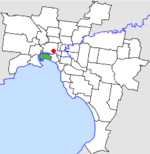Coode Canal
Canals in AustraliaCanals opened in 1886Docks (maritime)Port of MelbourneRecipients of Engineers Australia engineering heritage markers ... and 1 more
Yarra River

Coode Canal is a reach of the lower Yarra River in Melbourne, the capital city of the Australian state of Victoria. The canal was excavated in 1886, as part of harbour improvements designed by Sir John Coode to improve access for ships to Melbourne's main river docks. It created Coode Island and caused the shallow, narrow and winding Fishermans Bend to be cut off along with other sections of the river including Humbug Reach and the original junction with the Maribyrnong River (or Saltwater River).Coode Canal and Victoria Dock received an Engineering Heritage Marker from Engineers Australia as part of its Engineering Heritage Recognition Program.
Excerpt from the Wikipedia article Coode Canal (License: CC BY-SA 3.0, Authors, Images).Coode Canal
Mackenzie Road, Melbourne West Melbourne
Geographical coordinates (GPS) Address Nearby Places Show on map
Geographical coordinates (GPS)
| Latitude | Longitude |
|---|---|
| N -37.815277777778 ° | E 144.90722222222 ° |
Address
Mackenzie Road
3011 Melbourne, West Melbourne
Victoria, Australia
Open on Google Maps









